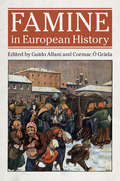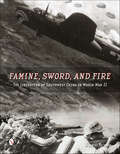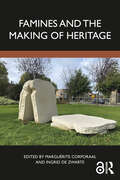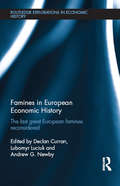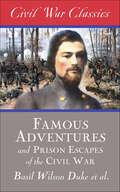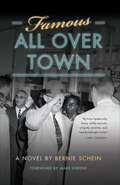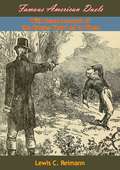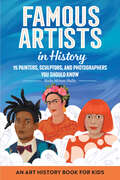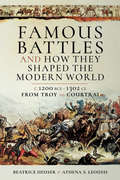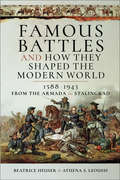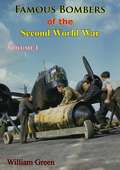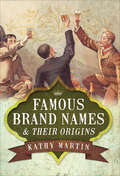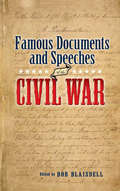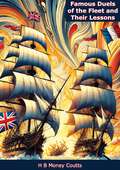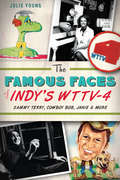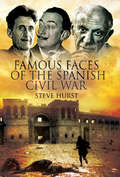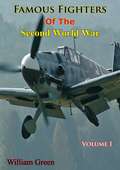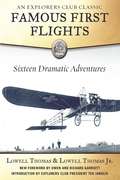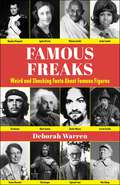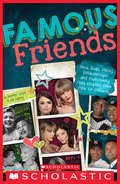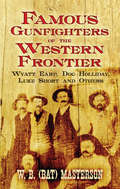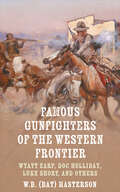- Table View
- List View
Famine in European History
by Guido Alfani Gráda Cormac ÓThis is the first systematic study of famines in all parts of Europe from the Middle Ages until the present. In case studies ranging from Scandinavia and Italy to Ireland and Russia, leading scholars compare the characteristics, consequences and causes of famine. The famines they describe differ greatly in size, duration and context; in many cases the damage wrought by poor harvests was confounded by war. The roles of human action, malfunctioning markets and poor relief are a recurring theme. The chapters also take full account of demographic, institutional, economic, social and cultural aspects, providing a wealth of new information which is organized and analysed within a comparative framework. Famine in European History represents a significant new contribution to demographic history, and will be of interest to all those who want to discover more about famines - truly horrific events which, for centuries, have been a recurring curse for the Europeans.
Famine in North Korea: Markets, Aid, and Reform
by Stephan Haggard Marcus NolandIn the mid-1990s, as many as one million North Koreans died in one of the worst famines of the twentieth century. Stephan Haggard and Marcus Noland present the most comprehensive and penetrating account of the famine to date, examining not only the origins and aftermath of the crisis but also the regime's response to outside aid and the effect of its current policies on the country's economic future. North Korea's famine exemplified the depredations that can arise from tyrannical rule and the dilemmas such regimes pose for the humanitarian community. To reveal the state's culpability is a vital project of historical recovery, especially in light of our current engagement with the "North Korean question."
Famine in North Korea: Markets, Aid, and Reform
by Stephan Haggard Marcus NolandIn the mid-1990s, as many as one million North Koreans died in one of the worst famines of the twentieth century. The socialist food distribution system collapsed primarily because of a misguided push for self-reliance, but was compounded by the regime's failure to formulate a quick response-including the blocking of desperately needed humanitarian relief. As households, enterprises, local party organs, and military units tried to cope with the economic collapse, a grassroots process of marketization took root. However, rather than embracing these changes, the North Korean regime opted for tentative economic reforms with ambiguous benefits and a self-destructive foreign policy. As a result, a chronic food shortage continues to plague North Korea today. In their carefully researched book, Stephan Haggard and Marcus Noland present the most comprehensive and penetrating account of the famine to date, examining not only the origins and aftermath of the crisis but also the regime's response to outside aid and the effect of its current policies on the country's economic future. Their study begins by considering the root causes of the famine, weighing the effects of the decline in the availability of food against its poor distribution. Then it takes a close look at the aid effort, addressing the difficulty of monitoring assistance within the country, and concludes with an analysis of current economic reforms and strategies of engagement.North Korea's famine exemplified the depredations that can arise from tyrannical rule and the dilemmas such regimes pose for the humanitarian community, as well as the obstacles inherent in achieving economic and political reform. To reveal the state's culpability in this tragic event is a vital project of historical recovery, one that is especially critical in light of our current engagement with the "North Korean question."
Famine, Sword, And Fire: The Liberation of Southwest China in World War II
by Daniel JacksonIn 1942, the Japanese conquered southwest China; in 1944, a joint Chinese-American campaign took it back
Famine: A Short History
by Cormac Ó GrádaFamine remains one of the worst calamities that can befall a society. Mass starvation--whether it is inflicted by drought or engineered by misguided or genocidal economic policies--devastates families, weakens the social fabric, and undermines political stability. Cormac Ó Gráda, the acclaimed author who chronicled the tragic Irish famine in books like Black '47 and Beyond, here traces the complete history of famine from the earliest records to today. Combining powerful storytelling with the latest evidence from economics and history, Ó Gráda explores the causes and profound consequences of famine over the past five millennia, from ancient Egypt to the killing fields of 1970s Cambodia, from the Great Famine of fourteenth-century Europe to the famine in Niger in 2005. He enriches our understanding of the most crucial and far-reaching aspects of famine, including the roles that population pressure, public policy, and human agency play in causing famine; how food markets can mitigate famine or make it worse; famine's long-term demographic consequences; and the successes and failures of globalized disaster relief. Ó Gráda demonstrates the central role famine has played in the economic and political histories of places as different as Ukraine under Stalin, 1940s Bengal, and Mao's China. And he examines the prospects of a world free of famine. This is the most comprehensive history of famine available, and is required reading for anyone concerned with issues of economic development and world poverty.
Famines and the Making of Heritage
by Marguérite Corporaal Ingrid De ZwarteFamines and the Making of Heritage is the first book to bring together groundbreaking research on the role of European famines in the nineteenth and twentieth centuries in relation to heritage making, museology, commemoration, education, and monument creation.Featuring contributions from famine experts across Europe and North America, the volume adopts a pioneering transnational perspective, and discusses issues such as contestable and repressed heritage, materiality, dark tourism, education on famines, oral history, multidirectional memory, and visceral empathy. Questioning why educational curricula and practices in schools and on heritage sites are region- or nation-oriented or transnational, chapters also consider whether they emphasise conflict or mutual understanding. Contributions also consider how present issues of European concern – such as globalisation, commodification, human rights, poverty, and migration – intersect with the heritage and memory of modern European famines. Lastly, the book considers what role emigrant and diasporic communities within and outside Europe play in the development of famine heritage and educational practices – and whether famine heritage is accessible to them.Famines and the Making of Heritage provides a crucial resource for museum and heritage scholars, students and professionals working on or with difficult or dark heritages, as well as those interested in the study of famines and legacies of troubled pasts.
Famines in European Economic History: The Last Great European Famines Reconsidered (Routledge Explorations in Economic History)
by Declan Curran Lubomyr Luciuk Andrew G. NewbyThis volume explores economic, social, and political dimensions of three catastrophic famines which struck mid-nineteenth and early-twentieth century Europe; the Irish Famine (An Gorta Mór ) of 1845–1850, the Finnish Famine (Suuret Nälkävuodet) of the 1860s and the Ukrainian Famine (Holodomor) of 1932/1933. In addition to providing new insights into these events on international, national and regional scales, this volume contributes to an increased comparative historiography in historical famine studies. The parallel studies presented in this book challenge and enhance established understandings of famine tragedies, including: famine causation and culpability; social and regional famine vulnerabilities; core–periphery relationships between nations and regions; degrees of national autonomy and self-sufficiency; as well as famine memory and identity. Famines in European Economic History advocates that the impact and long-term consequences of famine for a nation should be understood in the context of evolving geopolitical relations that extend beyond its borders. Furthermore, regional structures within a nation can lead to unevenness in both the severity of the immediate famine crisis and the post-famine recovery. This book will be of interest to those in the fields of economic history, European history and economic geography.
Famous Adventures and Prison Escapes of the Civil War (Civil War Classics)
by Basil Wilson DukeTo commemorate the 150th Anniversary of the end of the Civil War, Diversion Books is publishing seminal works of the era: stories told by the men and women who led, who fought, and who lived in an America that had come apart at the seams. For those who did not die on the battlefield, but who were instead taken prisoner, the Civil War presented an even more intense version of hell. Prison conditions were abysmal, and the prisoners frequently died of starvation and disease. These accounts of prison escapes show what desperate men will do, fleeing unequivocal peril to land behind enemy lines, struggling to get back to their own side and live to fight another day. Searing and difficult, this account puts readers into the minds of men at the precipice, willing to risk death for freedom.
Famous All Over Town: A Novel (Story River Bks.)
by Bernie ScheinThis sweeping comic novel examines the public and private upheavals of life in a small Southern town from the Civil Rights era to the new millennium.Famous All Over Town, the first novel from Southern storyteller Bernie Schein, is a comically candid multi-generational account of two Jews, a lowcountry native and a Northern transplant. Their lives interweave through the momentous events of a sleepy coastal hamlet based on Schein’s native Beaufort, South Carolina.Schein’s cast includes Southern Jewish lawyer Murray Gold and his foil, displaced New York psychiatrist Bert Levy. There’s also an emotionally scarred drill sergeant and his alluringly unconventional wife; a corrupt sheriff and his violent son; an African American madam and her two brilliant children; a fallen Southern belle; a transvestite Vietnam veteran; and many others. With their conflicted identities, burgeoning ambitions, and romantic entanglements, they live through the turbulent 1960s into the 1990s, confronting the ramifications of the civil rights era, Vietnam, Watergate, and—closer to home—a deadly version of the infamous Ribbon Creek incident.Foreword by Janis Owens.
Famous American Duels: With Some Account of the Causes That Led to Them (Essay Index Reprint Ser.)
by Don C. SeitzIn spite of the progress of civilization, the duel survived well into the latter part of the twentieth century in the United States. This book, first published in 1929, represents a great resource to understanding the nature of duels in American history, providing an account of the causes that led up to them and describing the history behind many of the more notable duels throughout the years.A riveting book!
Famous Artists in History: An Art History Book for Kids (Biographies for Kids)
by Kelly Milner HallsAmazing stories of artists with a unique view of the world—for kids ages 8 to 12 Art makes the world a more beautiful and interesting place! Throughout history, all over the world, artists have created incredible pieces that inspired the hearts and minds of millions of people. This collection of biographies for kids explores the accomplishments of 15 artists from long ago and today, and how their diverse experiences and beliefs brought their work to life. This book of famous artists for kids includes: Stories set in stone—Learn about sculptors like Michelangelo and Gian Lorenzo Bernini, and how they used marble to make human bodies in incredible detail. Powerful pictures—Read the stories of photographers like Julia Margaret Cameron and Gordon Parks who captured the lives of ordinary people to draw attention to their struggles. Art as self-expression—Discover how Frida Kahlo and Jean-Michel Basquiat used their vibrant painting style to make bold statements about who they were and where they were from. Show any kid that they have a strong and creative point of view with this illuminating art history book.
Famous Battles and How They Shaped the Modern World, 1200 BCE–1302 AD: From Troy to Courtrai
by Beatrice Heuser Athena S. LeoussiWhy are some battles remembered more than others? Surprisingly, it is not just size that matters, nor the number of dead, the decisiveness of battles or their effects on communities and civilisations. It is their political afterlife the multiple meanings and political uses attributed to them that determines their fame. This ground-breaking series goes well beyond military history by exploring the transformation of battles into sites of memory and meaning. Cast into epic myths of the fight of Good against Evil, of punishment for decadence or reward for virtue, of the birth of a nation or the collective assertion against a tyrant, the defence of Civilisation against the Barbarians, Christendom against the Infidel, particular battles have acquired fame beyond their immediate contemporaneous relevance.The epic battles of European history examined in this first volume range from the siege of Troy and the encounters of Marathon and Thermopylai, to the wars of the Israelites which inspired the way many later battles would be narrated; and from the triumphs and defeats of the Roman Empire, to Hastings, the massacre of Bziers and the battle of Courtrai. In each chapter, the historical events surrounding a battle form the backdrop for multi-layer interpretations, which, consciously or unconsciously, carry political agendas.
Famous Battles and How They Shaped the Modern World, 1588–1943: From the Armada to Stalingrad
by Beatrice Heuser Athena S. LeoussiWhy are some battles remembered more than others? Surprisingly, it is not just size that matters, nor the number of dead, the decisiveness of battles or their effects on communities and civilisations. It is their political afterlife the multiple meanings and political uses attributed to them that determines their fame. This ground-breaking series goes well beyond military history by exploring the transformation of battles into sites of memory and meaning. Cast into epic myths of the fight of Good against Evil, of punishment for decadence or reward for virtue, of the birth of a nation or the collective assertion against a tyrant, the defense of Civilisation against the Barbarians, Christendom against the Infidel, particular battles have acquired fame beyond their immediate contemporaneous relevance.The great battles of modern history examined in this second volume range from the defeat of the Armada and the relief of Vienna, to Chatham, Culloden, Waterloo, Gettysburg, the Somme and Stalingrad. In each chapter, the historical events surrounding a battle form the backdrop for multiple later interpretations, which, consciously or unconsciously, carry political agendas, some for further bloodshed and sacrifice, but others for the more recent and laudable phenomenon of reconciliation over the graves of the dead.
Famous Bombers Of The Second World War, Volume One
by William GreenOriginally published in 1959 to much acclaim, William Green's Famous Bombers Of The Second World War, provides the most accurate and comprehensive view of the bomber aircraft that were used by both the Axis and the Allies. In this first volume, the author covers 18 different aircraft and their variants in their approximate order of introduction to operational service and provides a brief developmental and operational history of each type. Included are: Heinkel HE111, Savoia-Marchetti Sparviero, Boeing Fortress, Junker JU87, Dornier DO17, Vickers Wellington, Junkers JU88, Consolidated Liberator, North American Mitchell, Martin Marauder, De Havilland Mosquito and the Avro Lancaster.Widely regarded as a pioneering ground from author William Green, it is particularly noted for the many excellent illustrations by G.W. Heumann and comprehensive side profiles of major sub-types, this volume also includes a highly detailed 3-view artwork.
Famous Brand Names & Their Origins
by Kathy Martin&“This fascinating and enjoyable book tells the story of around 200 brand names, delving succinctly into their origins and fortunes over time&” (Your Family History). Many brands, including Boots, Hoover, and Kelloggs, were named after their founders whilst others have less obvious origins; for instance, did you know that Velcro comes from velours and crochet, the French words for &“velvet&” and &“hook?&” This entertaining book by Kathy Martin explores the stories behind the brands, their names, and their founders. Bursting with fascinating facts and period advertising, this must-read book will appeal to everyone interested in advertising, social history, food, and famous names. &“A well-written, slightly idiosyncratic and thoroughly delightful book. That the author knows and loves her subject is very evident . . . It is likely to have wide appeal, and be of use to both Historians and Joe and Jane Public.&” —NZ Crown Mines
Famous Civil War Documents and Speeches
by Bob Blaisdell"We must have peace, not only in Atlanta, but in all America," declared General Sherman to the civic leaders who protested against the evacuation and burning of their city. "We don't want your Negroes, or your horses, or your lands, or anything you have, but we do want and will have a just obedience to the laws of the United States. That we will have, and if it involves the destruction of your improvements, we cannot help it."Sherman's impassioned but well-reasoned reply to the city fathers is but one of the many key documents, memorable speeches, and moving letters and reports in this collection of historic statements from the American Civil War. Even the most dedicated of buffs is likely to find something new in this compendium, which ranges from familiar items such as the Gettysburg Address to private reflections, including Stonewall Jackson's message to his wife after the Battle of First Manassas, and excerpts from the diary of a Confederate soldier at the siege of Vicksburg.Other highlights include "The War and How to End It," a lecture by Frederick Douglass; Robert E. Lee's farewell to the Army of Northern Virginia; an eyewitness account of the clash between the Monitor and Merrimack; and reports by commanding officers from both sides of the Mason-Dixon line--Ulysses S. Grant on the battle at Shiloh, Joseph Hooker's account of Antietam, and James Longstreet's Wilderness Campaign report.
Famous Duels of the Fleet and Their Lessons
by H B Money CouttsDelve into the thrilling and dramatic world of naval warfare with H. B. Money Coutts's Famous Duels of the Fleet and Their Lessons. This compelling work brings to life some of the most notable naval duels in dur the French Revolutionary and Napoleonic Wars, offering readers a detailed and vivid account of these intense maritime conflicts and the strategic insights they provide.H. B. Money Coutts, a respected historian and naval expert, meticulously examines a series of famous naval engagements, exploring the tactics, leadership, and bravery that defined these encounters. Through clear and engaging narrative, Coutts reconstructs each duel, providing readers with an immersive experience of the action and decision-making that took place on the high seas.Famous Duels of the Fleet and Their Lessons is an essential read for naval enthusiasts, historians, and anyone interested in the intricacies of maritime warfare. Coutts's thorough research and engaging storytelling make this book both informative and captivating, shedding light on the heroism and strategic genius that have shaped naval history.Join H. B. Money Coutts on a journey through the high-stakes world of naval duels, and discover the lessons of courage, strategy, and leadership that emerge from these historic encounters. Famous Duels of the Fleet and Their Lessons is a timeless exploration of naval warfare that continues to inspire and educate readers about the enduring legacy of naval conflict.
Famous Faces of Indy's WTTV-4, The: Sammy Terry, Cowboy Bob, Janie and More
by Julie YoungGrowing up in central Indiana in the 1960s, '70s and '80s would not have been complete without our favorite hosts from WTTV-Channel 4. Sammy Terry set the spooky scene for Friday-night fright flicks. Cowboy Bob rode in on horseback with daily delights at the corral. Commander KC brought education to television. Along with Janie Hodge, Peggy Nicholson and regional characters, these local hosts were bona fide television stars before national programs began broadcasting kids' shows around the clock. WTTV's homegrown shows and endearing hosts endure in the hearts of their loyal fans. Join historian Julie Young on a journey behind the curtain of your favorite Channel 4 shows, as she offers a look at a pre-cable era when shows were live, hosts were local celebrities and anything could happen
Famous Faces of the Spanish Civil War: Writers and Artists in the Conflict, 1936–1939
by Steve HurstThis book tells the tragic story of the Spanish Civil War through the eyes of writers, artists and musicians who were deeply involved and close to it. By means of chronological chapters covering the major phases the author describes the roles of figures such as Arthur Koestler, Ernest Hemingway, Pablo Picasso, George Orwell, Esmond Romilly, Martha Gellhorn (Hemingways lover), Salvador Dali, the poet Federico Lorca (who was killed) etc. Other famous names include the spies Kim Philby and Anthony Blunt. The progress of the War is followed from the outbreak rebellion of summer 1936, through Seville, the war in the Aragon Mountains, Madrid, Malaga, the arrival of the International Brigades in 1937, the notorious destruction of Guernika by the German Condor Legion, Barcelona and Francos victorious march, checked briefly on the Ebro. This is a highly informative and interesting work covering a period of military history that has been largely neglected.
Famous Fighters Of The Second World War, Volume One
by William GreenThis volume is the 1960 follow-up to the 1959 publication "Famous Bombers of the Second World War: Volume One," William Green here covers a further extensive number of aircraft focussing on the fighters used by the Axis and Allies during the Second World War. As before the types in approximate order of introduction to operational service and providing a brief developmental and operational history of each type. Includes ME Komet, Hawker Hurricane, Supermarine Spitfire, Mustang, FW190, the Russian YAK series, Hellcat, Mitsubishi Zero, BF109 and the Lockheed Lightning.An Invaluable companion to Volume One, as beautifully and comprehensively illustrated as before.
Famous First Flights: Sixteen Dramatic Adventures (The\explorers Club Classics Ser. #Vol. 3)
by Lowell Thomas Lowell Thomas Jr. Owen Garriott Richard GarriottWithin this classic volume are the tales, tribulations, and ultimate triumphs behind some of the most spectacular and break-taking aerodynamic feats of early twentieth century aviation. Recounted firsthand from the annals of history, Famous First Flights will lift readers directly from the pages and into the action. Join the exhilarated crowd as they watch French flying ace Louis Bleriot make the first air journey over water in 1909. Be on the ground in Paris to welcome Lindbergh and his magnificent The Spirit of St. Louis upon the landing of the first solo transatlantic flight. Hold your breath with Ross Macpherson Smith and his crew on their infamously trouble-plagued trek from London to Australia in 1919. And relive the excitement and awe experienced 'round the world as "The Magellans of the Air" completed the first circumnavigation of the globe via air in 1965. In these and thirteen other recounts of jaw-dropping feats, celebrated aviators Lowell Thomas and Lowell Thomas Jr, deliver another must-have volume in the Explorer's Club Classic Series. With over forty photographs and new updates on ballooning and space flights, Famous First Flights is must-have compendium for every arm-chair pilot and aviation enthusiast.
Famous Freaks: Weird and Shocking Facts About Famous Figures
by Deborah WarrenDid you know Thomas Edison proposed to his wife in Morse code? Or that the CIA considered covering Castro&’s shoes in thallium to get rid of his iconic beard? The strange facts and foibles of history&’s famous figures are divulged in Famous Freaks. The book is a fun, bite sized compendium of the weird and unbelievable. Big names—small disclosures. Important historical data—little to none. This book can be picked up and read anywhere, from any starting point. Skim a section or just peruse a page, but you may find yourself hooked after reading a few of the hilariously strange entries inside. Deborah Warren, whose work has appeared in The New Yorker and The Paris Review, deals out the strange facts of history&’s famous with a poetic style and a sense of humor. The collected details, those which history might rather have forgotten, are given their place in the spotlight. Start from the front, but if it&’s not your thing, flip around the pages. There are plenty of Famous Freaks inside.
Famous Friends: Best Buds, Rocky Relationships, and Awesomely Odd Couples from Past to Present
by Jennifer Castle Bill SpringFrom John Adams and Thomas Jefferson's "bromance" to Taylor Swift's unstoppable squad, Famous Friends takes readers inside some of the most celebrated friendships throughout history and today.Did you know that John Adams and Thomas Jefferson, friends and political rivals, died only hours apart from each other on the 50th anniversary of the signing of the Declaration of Independence? Or that famed magician Harry Houdini and Sherlock Holmes creator Arthur Conan Doyle were besties until a seance gone wrong ruined their friendship? Famous Friends explores fascinating stories like these to find out what happens when someone who is really famous becomes friends with someone ELSE who's really famous. Famous Friends brings history to life with a funny and conversational tone, color photos, and a dynamic design. Sidebars with historical context help position each friendship in its time period as readers travel from the early days of the American colonies to today's biggest celebrity pairings. From the original "bromance" to #squadgoals, get ready to learn about the coolest friendships of all time.
Famous Gunfighters of the Western Frontier: Wyatt Earp, Doc Holliday, Luke Short and Others
by W. B. MastersonA legendary lawman, buffalo hunter, Indian fighter, and newspaper columnist, Bat Masterson served as sheriff of Ford County, Kansas, ruled Dodge City, and became an eyewitness to the heyday of the Old West's most notorious outlaws. His thrilling collection of mini-biographies reveals fascinating details about a host of legendary gunslingers, painting a vivid portrait of a world of sharpshooters, cattle rustlers, and frontier justice. First published as a series of magazine articles in 1907, these life-and-death dramas introduce you to some of the most famous gunfighters America has ever known. The roundup includes Wyatt Earp, who had a reputation for courage and calm, but went on the warpath when one of his five brothers was killed by stagecoach robbers; Doc Holliday, a mean-tempered dentist who loved poker and moonshine—and found trouble wherever he traveled; Ben Thompson, a fearless gunman who served in the Civil War and was determined to continue fighting after the last battle ended; Luke Short, a slightly built man with nerves of steel, who started out as a gambler and ended up a Shakespeare-quoting gentleman; and Bill Tilghman, who captured some of the West's most desperate criminals. Illustrated with forty-eight rare nineteenth-century photos, these colorful accounts will appeal to anyone with a love of Western lore.
Famous Gunfighters of the Western Frontier: Wyatt Earp, Doc Holliday, Luke Short and Others
by W. B. MastersonDiscover these tales of frontier justice and life-and-death struggles will transport you to a bygone era of adventure and excitement. Originally published in 1907, Bat Masterson's gripping collection of short biographies introduces you some of the most famous lawmen and notorious outlaws of the Wild West, including cattle rustlers, sharpshooters, and gunslingers. From Doc Holliday and Wyatt Earp to lesser known figures like Luke Short, Famous Gunfighters of the Western Frontier is packed with daring feats and larger-than-life characters.
